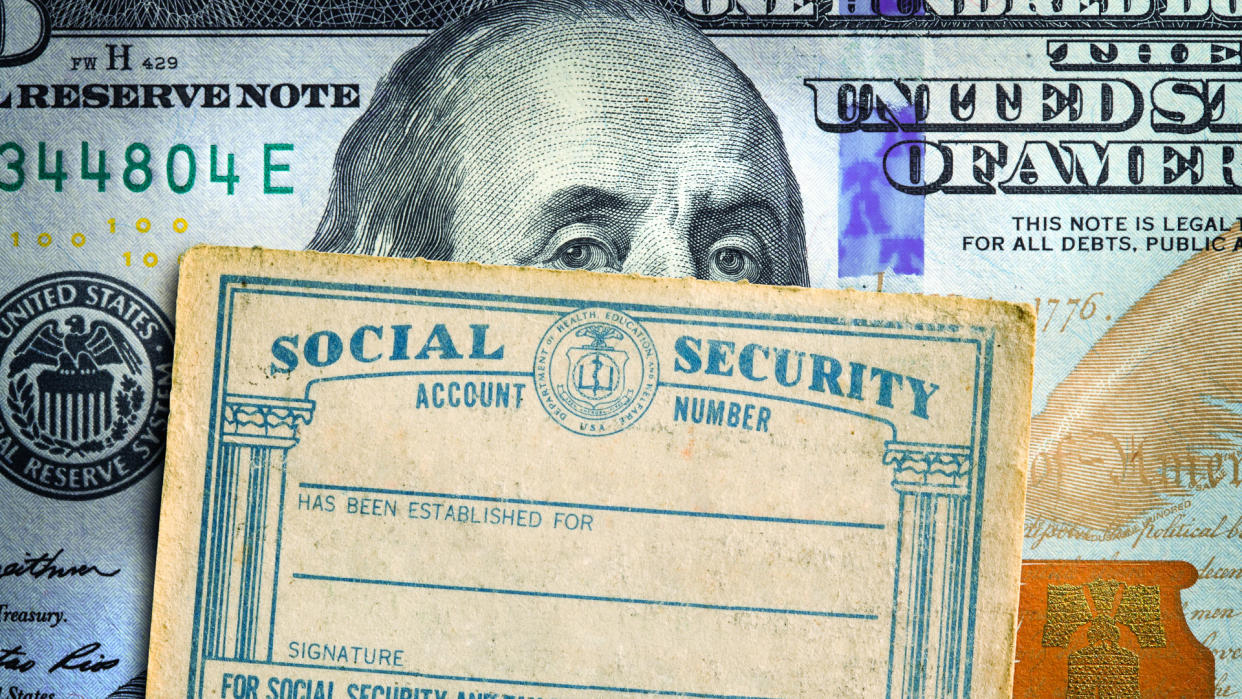What Social Security could look like in 2035
The future of Social Security remains uncertain, forcing people to ask questions like, “Will Social Security run out?” According to the 2021 annual report from the Social Security board of trustees, Social Security’s cash reserves will be fully depleted by 2034 — one year earlier than their 2020 report indicated. Annual taxes are expected to cover only about 78% of the benefits each year after that.
Good Question: What Is the Average Social Security Benefit at Age 62?
Advice: With a Recession Looming, Make These 3 Retirement Moves To Stay On Track
Social Security: Women Get $354 Per Month Less Than Men – Here’s Why
See what else awaits Social Security in the near future and find out what the program will look like in 2035 — you might want to learn how to stretch your money now.
Why Social Security Is In Trouble
Part of the problem can be attributed to longer life expectancies, a smaller working-age population and an increase in the number of retirees. By 2035, the number of Americans 65 and older will increase to more than 78 million from about 56 million today. As a result, more people will be taking money out of the Social Security system — but there will be fewer people paying into it.That doesn’t mean the program will run out of money entirely, though. Payroll taxes are expected to cover about 78% of scheduled benefits. But, if the funding gap isn’t filled, retirees could get lower Social Security payments or workers might need to pay more into the system. If no changes are made, this is what Social Security could look like in the future, according to experts.Take Our Poll: Do You Think Student Loan Debt Should Be Forgiven?
The Worst-Case Scenario: Benefits Could Be Cut
If you plan to rely on the program in 2035, keep in mind there’s a chance you could receive less in Social Security benefits than you might have expected. If no changes are made to deal with the trust fund shortfall, benefits will have to be reduced by 22%, according to the 2021 annual report from the board of trustees.For many retired adults, that kind of cut in benefits would represent a big financial hit. Social Security provides at least half of the income for 50% of elderly married couples and 70% of elderly single people, according to the Social Security Administration.
Is It Likely That Benefits Will Be Cut?
Some experts doubt that a big slash in Social Security benefits is forthcoming.”The ramifications of that event would be beyond traumatic for everyone in the country,” said Joseph E. Roseman Jr., a Social Security expert and retirement planner at Retirement Capital Planners. “You’ve got a national disaster on your hands.”That’s why he thinks Congress will step in before 2035 to prevent such a deep cut in benefits. Mary Beth Franklin, a Social Security expert and contributing editor for Investment News, agrees that a big cut in benefits is unlikely.”As pensions are disappearing, people are relying more on Social Security,” she said. Because of the program’s popularity, politicians won’t want to tinker with benefits for existing retirees and will likely have to find other solutions to the trust fund shortfall.
Ways To Balance Social Security’s Budget
Even though Social Security isn’t expected to run out of money until 2034-35, several options for changes have already been floated to deal with the budget shortfall. These options include:Raising the payroll tax rate
Increasing the wages subject to Social Security taxes
Raising the full retirement age
Reducing the annual cost-of-living adjustments
Cutting benefits
Read on to learn more about the details of each of those proposals and how they would affect Social Security if implemented.
The Social Security Payroll Tax Rate Could Rise
If benefits aren’t cut, tax revenue for the program will likely have to increase. One way to do that is to increase the payroll tax rate. Social Security is funded through a 6.2% payroll tax that workers pay, plus another 6.2% that employers pay (self-employed people have to pay the full 12.4%).
What Would Happen
As the trust fund reserves dwindle down, the payroll tax would need to increase enough to sustain the program. If nothing is done until 2034 or 2035, that increase would need to be sharper.However, Roseman doesn’t expect Congress to raise the payroll tax to boost trust fund reserves. “There’s probably the least appetite for that than anything you can look at,” he said. “It’s a tax increase.”
What Social Security Would Look Like in 2035 With This Change
An increase in the payroll tax rate could take different forms. Currently, the total payroll tax is allocated equally between the employee and the employer. The tax increase could be allocated equally among employers and employees or allocated more to the employer to hide the tax hike from taxpayers.A legislative proposal called the Social Security 2100 Act from Rep. John Larson (D-Conn.) favors the latter option. It would raise the federal payroll tax rate by 6.2% for employers, and would only raise taxes on employees making more than $400,000. The bill has gained some support but so far has stalled in Congress, Politico reported.
More Wages Could Be Taxed
Another option to increase tax revenue to fund Social Security is to raise the amount of earnings subject to taxation. Only the amount of wages up to the Social Security contribution and benefit base are subject to Social Security taxes.
What Would Happen
To help the trust fund remain solvent, the taxable wage limit would have to be even higher — or lifted entirely — so that all income would be subject to the payroll tax, Franklin said. This change would affect high-income people whose earnings above $137,700 currently escape taxation for Social Security.
What Social Security Would Look Like in 2035 With This Change
Raising the taxable wage limit would only affect people whose wages exceed the current contribution and benefit base. For example, if you make $80,000 per year, you pay Social Security taxes on all of your income, so whether the limit is $130,000, $300,000 or removed entirely, it doesn’t affect your payroll taxes.However, if you make $250,000 as a W-2 employee, you only pay Social Security taxes on the first $137,700, for a total of $8,537.40. If the limit went up to $300,000, you would pay Social Security taxes on all of your $250,000 income, for a total of $15,500.
The Full Retirement Age Could Increase
Because tax hikes aren’t popular, Congress will more likely raise the full retirement age for Social Security benefits, Roseman said. That means younger generations will have to work longer before they can start collecting benefits.Currently, the age at which you can collect full retirement benefits ranges from 65 if you were born in 1937 or earlier, to 67 if you were born in 1960 or later.
What Would Happen
Both Roseman and Franklin said there are proposals to raise the full retirement age gradually to 69 — that would keep more money in the trust funds. At the same time, it might eliminate a popular strategy that retirees use to maximize Social Security income. Currently, if you delay collecting retirement benefits past your full retirement age, your benefit increases each year you wait until age 70, Roseman said.
What Social Security Would Look Like in 2035 With This Change
As life expectancy increases, raising the retirement age might seem like a reasonable response because people have longer to work. However, raising the retirement age essentially cuts benefits because it delays the payments of benefits that people are expecting. In addition, the overall longevity increases haven’t applied to many low-income workers, who have shorter life expectancies than wealthy people. People with low incomes would likely be the hardest hit by increasing the retirement age.
The Social Security COLA Could Be Reduced
Retirees receiving Social Security benefits typically see their checks increase slightly most years to keep pace with inflation. These cost-of-living adjustments — or COLAs — are based on the consumer price index. The last few years saw a 2.8% boost in both 2018 and 2019, a 1.6% increase for 2020 and a whopping 5.9% increase for 2021.
What Would Happen
To keep the Social Security trust funds solvent, there could be changes to cost-of-living adjustments, Roseman said. Most likely, the formula wouldn’t change for people born before 1960. But, people born after 1960 might see a reduced COLA, he said.If that happens, benefit checks will not keep pace with inflation. People who rely heavily on Social Security might have to find ways to reduce spending to make ends meet.
What Social Security Would Look Like in 2035 With This Change
As some of the past years have shown, inflation adjustments to Social Security benefits can be small. Low cost-of-living adjustments could make it very hard for people living on fixed incomes to pay their expenses in places where housing and rent costs are rising each year. Plus, seniors spend more than younger people on healthcare costs, which tend to rise faster than the cost of inflation.
Benefits Could Be Cut
The funding shortfall could be solved by cutting benefits for all Social Security beneficiaries — including those who are currently receiving benefits — or simply cutting benefits for future Social Security beneficiaries. If nothing is done until 2034 or 2035, however, all benefits would need to be reduced by 22%.
What Would Happen
Should the Social Security reserves run out in 2034-35, benefit cuts could take various forms. The simplest cut would be an equal one across the board. Another option would be to cut benefits differently based on income. For example, the top 25% or top 50% of earners might see their benefits reduced, whereas benefits for lower-income Social Security recipients would remain intact.Similarly, Social Security could become a means-tested benefit, determined in part by the recipient’s income or other assets. Currently, if you paid into the Social Security system, you’ll receive benefits regardless of your income or assets.
What Social Security Would Look Like in 2035 With This Change
In 2020, the average retirement benefit was $1,503 per month. If benefits were cut by 20% across the board, the average benefit would drop by about $301 each month, or $3,612 per year. If benefits were to drop by 23%, the monthly decline would be $346, or $4,152 per year.
Is This an Easy Problem To Solve?
As Roseman sees it, the Social Security shortfall problem is easy to solve — but it’s not easy to get Congress to make the necessary changes. “Nobody wants to compromise,” he said.Nonetheless, Roseman doesn’t expect Social Security to run out of money. He tells his clients to count on it as a source of retirement income, but it shouldn’t be their only source of retirement income. “I would never advise anybody to live on Social Security alone,” he said.More From GOBankingRates5 Best Southern Cities To Retire on a Budget of $1,500 a Month
Explore GOBankingRates’ 2023 Banking Resource Center
The 10 Best Rewards Credit Cards for 2023
How To Save Money When Filing Taxes
Joel Anderson, Michael Keenan and Gabrielle Olya contributed to the reporting for this article.
This article originally appeared on GOBankingRates.com: What Social Security Could Look Like in 2035
Source: Read Full Article





















